
Perfect 2 weeks Sri Lanka Itinerary
The perfect 2 weeks Sri Lanka itinerary is relative and highly decided by personal taste. The perfect 2 weeks Sri Lanka itinerary can be either on Sri Lanka’s northern route or the southern Sri Lanka tour package. On this 2 week Sri Lanka itinerary, from the cities of Sri Lanka’s southern coast to Sri Lanka’s quiet country trails, we sample Hambantota beach and Ella, Buddhist architecture, pristine beaches and mountain scenery.
Table of Contents
- Important places included in the perfect 2 weeks Sri Lanka itinerary
- Useful reading
- 2 weeks Sri Lanka itinerary in a nutshell
- What is the best transport mode for the trip?
- The flow of 2 week Sri Lanka trip
- Seri Lanka 2 weeks tour package- beach holiday
- Price of Sri Lanka 2 weeks tour
- 2 weeks Sri Lanka itinerary: visiting Hambantota-beach
- 2 weeks Sri Lanka itinerary: Best for mountains and Tea
- 2 weeks Sri Lanka itinerary: visiting Kandy for architecture
- 2 weeks Sri Lanka itinerary: Best for walking
- 2 weeks Sri Lanka itinerary: best for historical wonders
The perfect 2 weeks Sri Lanka itinerary is relative and highly decided by personal taste. The perfect 2 weeks Sri Lanka itinerary can be either on Sri Lanka’s northern route or a southern Sri Lanka tour package. On this 2 week Sri Lanka itinerary, from the cities of Sri Lanka’s southern coast to Sri Lanka’s quiet country trails, we sample Hambantota beach and Ella, Buddhist architecture, pristine beaches and mountain scenery.
On this 2 weeks Sri Lanka itinerary, from the cities of Sri Lanka’s southern coast to its quiet country trails, we sample Hambantota beach, Ella mountain resort, and Nuwara Eliya, Buddhist architecture, pristine beaches and mountain scenery.
Important places included in the perfect 2 weeks Sri Lanka itinerary
- Colombo
- South coast beach: Hambantota
- Yala
- Ella
- Nuwara Eliya
- Kandy
- Cultural triangle of Sri Lanka
Useful reading
- Sri Lanka package tour
- Honeymoon tour package Sri Lanka
- Negombo city tour
- Sri Lanka tour deals-early bird offers
- Sri Lanka tour holidays
- Classic Sri Lanka southern tour
- Sri Lanka splendour tour 7 days
- Sri Lanka whale-watching tour from Kalutara, Bentota and Colombo
- Sri Lanka cultural triangle tour
2 weeks Sri Lanka itinerary in a nutshell
- Day 1: Arrival and driver to Galle and the south coast
- Day 2-3: Sightseeing tour of the Southern coast
- Day 4-5: Sightseeing tours in Ella and trekking, Hiking
- Day 6-7: Visiting Nuwara Eliya
- Day 8-9: Visiting Kandy
- Day 10-12: Visiting the cultural triangle of Sri Lanka
- Day 13: Drive to Colombo
- Day 14: Departure
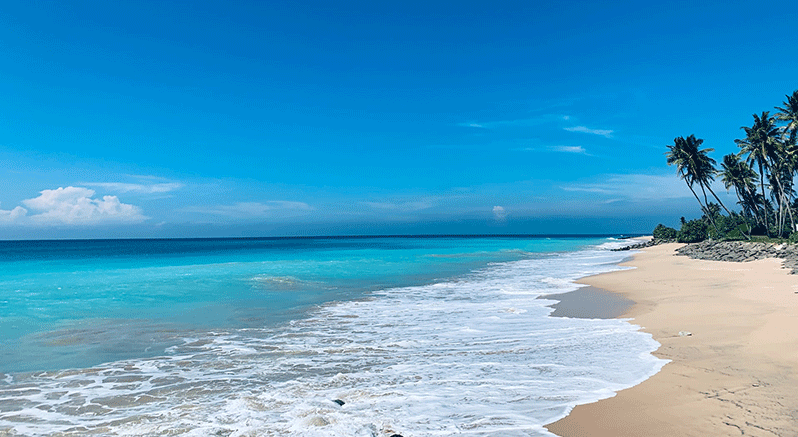
What is the best transport mode for the trip?
Travel by private taxi is the best transport mode for your 2 weeks tour in Sri Lanka. We always recommend our readers arrange a private taxi with a local driver/guide for their trips., due to many reasons. The most important advantage of having a private taxi is the convenience of visiting monuments and driving around the island. Having a private taxi allows you to have a comfortable and safe tour in Sri Lanka while enjoying your maximum privacy. When you have private transport you can also customize your trip along the way with minor changes changes to the program, however, when you travel with a group you will not get that flexibility. Train transport and travel by public bus are very cheap in Sri Lanka, however, they cannot be considered a viable option for a trip to Sri Lanka.
The flow of 2 week Sri Lanka trip
The flow of the two weeks trip that we discuss here is a little bit different than most Sri Lanka trips. Most Sri Lanka trips start in Colombo, and so is the 2 weeks trip that we discuss here, however, the flow of most other trips is in the clockwise direction. This 2-week trip goes in the opposite direction, anti-clockwise direction.
When the tour takes place in a clockwise direction the travellers first travel to historical monuments and cultural sites in the cultural triangle of Sri Lanka. Later they travel to Sri Lanka hill country tourist attractions and cities like Kandy, and Nuwara Eliya. Later they proceed to southern Sri Lanka cities such as Yala and Tissamaharama and the trip comes to the end with a beach holiday on the south or west coast.
The trip takes place in an anti-clockwise direction is not very common and popular among travellers. On a trip that goes the anti-clockwise direction, the travellers first visit the beach areas and later travel to the south coast. The travellers spend some time on the beach and have leisure at the beginning of the trip and later they travel to the south coast, Sri Lanka’s hill country. Towards the end of the trip, they explore the historical monuments in the cultural triangle.
Seri Lanka 2 weeks tour package- beach holiday
In this 2 weeks Sri Lanka tour package, the guests are travelling to the south coast beach right after arriving in Sri Lanka. Sri Lanka’s south coast is one of the best places for sun seekers and a large number of pristine beaches such as Mirissa, Hambantota and Tangalle are very suitable for a peaceful leisurely beach stay. In Sri Lanka 2 weeks tour package the travellers spend their first 3 days on the south coast beach, and they start their trip with some relaxing on the south beach. The 2 weeks Sri Lanka tour is planned in such a way that it includes only 3 days stay on the south coast, however, since this is a private tour the travellers can increase the number of days of their beach stay. The number of days on the beach on the south coast can be increased to around 5-7 days without affecting the 14 days tour itinerary. However, this 2 weeks trip includes 3 days of beach stay in order to facilitate a leisurely tour around Sri Lanka.
Price of Sri Lanka 2 weeks tour
The price of a Sri Lanka tour varies due to many reasons. The largest contributor to the price of a Sri Lanka 2 weeks tour is the cost of accommodation. Choosing affordable accommodation facilities such as 3-star hotels allows the travellers to curtail the price of the trip by a great amount. However, travellers, who wish to have a luxury two weeks tour can also book their trip with hotels such as 5-star hotels or luxury boutique hotels. You will travel around 1300km on Sri Lanka 2 weeks tour itinerary and therefore, transport cost also causes a swell in the tour package spice. Other major factors that increase the tour package price are the entrance fees to the tourist sites, and activities such as wildlife safari. On 2 week, Sri Lanka tour the travellers need to spend around US$200 for entrance fees and activities. The entrance fees to tourist monuments and activity cost is increased in Sri Lanka over the last few years.
2 weeks Sri Lanka itinerary: visiting Hambantota-beach
On the southern tip of Sri Lanka is the empty pristine beaches of Hambantota, tucked away 250 km from Colombo. Hambantota sits far away from over-developed tourist destinations on the west coast such as Bentota and Hikkaduwa, which have taken the name of Sri Lanka to the world as one of the best beach holiday destinations in the world.
Cooled by the torque waters of the Indian Ocean and backed by evergreen dry zone forests, the beaches that dot the coast of Hambantota are continental in scope: across the water, many countries such as Thailand, Japan, and India are within a few hours away with a boat. Hambantota is a fascinating place, which is only a few hundred meters away from the international sea route, you can see hundreds of massive ships from the beach that move hastily passing Hambantota. Hambantota is the southernmost spec of land on the world map and the next major land to encounter after Hambantota is Antarctica, after many thousands of empty seas.
Spotting whales on your Sri Lanka 2 weeks tour itinerary
The sea off Hambantota is not only frequented by commercial ships but also whale-watching cruise ships. Most of these ships set off from the harbour of Mirissa and Tangalle in search of blue whales. The sea off Hambantota belongs to the international whaling commission’s protected zone in the Indian Ocean, and therefore, commercial whaling is strictly prohibited here.
A few hundred meters from the Hambantota beach, an array of endangered whale species swim alongside dolphins and rare sea turtle species. A number of blue whales have made the sea off Hambantota their permanent resident, Cetacean Researchers opine that many hundreds of resident whales are living around southern Sri Lanka. These resident whales are joined by migratory whales from the Arabian Sea in the month of March, April and May making it a memorable spectacle for whale enthusiasts.
Aboard the whale-watching boats that set sail from, southern Sri Lankan harbours such as Mirissa and Dondra, there are gasps when an ocean giant glides into view. With palm-fringed sandy beaches in the backdrop, this is one of the world’s greatest wildlife shows.
Seerendipity tours offer daily whale-watching trips to Mirissa from Bentota and Colombo. The whale-watching trip can be booked as a Sri Lankan day trip from Colombo and the west coast or as 2 day Sri Lanka trip from Colombo and west coast beach resorts. 2 days whale watching trip includes an overnight stay in Mirissa as well as many other tourist places such as Galle, a Boat tour of Madu estuary, Hikkaduwa beach, sea turtle conservation project etc.
Spotting wildlife on your Sri Lanka 2 weeks tour itinerary
Despite its vast sandy beaches, pristine forest cover, animal-rich wildlife parks, and thousands of years of historical monuments, Hambantota is still underdeveloped from a tourist perspective. You will not encounter hordes of sun-worshippers on the beaches of Hambantota or many dozens of luxury beach resorts with a large stock of rooms.
The number of holidaymakers is very low here, which means the beaches are still intact. The remotely located Hambantota has a low profile, which is also a city with a low population means the nature around Hambantota is least disturber due to the human intervention.
Less than 1-hour drive from Hambantota is another natural jewel of Sri Lanka, where nature certainly seems to dominate the broad sweep of sand, Yala national park, which is considered the best place in the world to see wild leopards. Every day, hundreds of local as well as foreign travellers undertake costly wildlife safari tours based in Yala national park. Most of them are in search of creatures such as leopards, elephants, bears, jackals, and most travellers are able to quench their desire to spot some of these wild animals.
Turtle watching in Hambantota
Sri Lanka is home to a large number of endangered sea turtles. The waters around Sri Lanka host 5 endangered sea turtle species. Swimming with sea turtles, volunteering for the sea turtle conservation project, and turtle watching in Rekawa are some of the popular activities among tourist in Sri Lanka. Turtle conservation centres are popular trip places in Sri Lanka included in most trips like 5 days tours, 7 days Sri Lanka tours and it includes even Sri Lanka day trips.
30 km from Hambantota is Rekawa beach, where nature certainly seems to dominate the broad sweep of sand. Rekawa is considered to be one of the 10 best places in the world to see endangered sea turtles. The protected sandy beaches of Rekawa are kept away from development activities by the wildlife department, in order to protect nature. Visitors, mostly foreigners gather here to encounter sea turtles. The vast isolated open beach is best to spot sea turtles on days with a bright moon.
Further information: Whale-watching trips include a wildlife briefing, breakfast, tea/coffee (US $ 49)
Where to eat: A large number of travellers gather at beach Restaurants in Hambantota, where the people are able to sample tasty food while enjoying the scenery on the pristine beach.
Where to stay: With quiet surroundings on the beaches of Tangle, a converted 16th-century-old colonial mansion, is one of the loveliest accommodation choices in southern Sri Lanka. Less than a dozen of large spacious rooms with elegant travels of Dutch and Buddhist inspiration, and there’s an Ayurveda spa, Bar, and beach pool on site. Many dozens of activities and sightseeing tours are available for houses guests from diving, and snorkelling to whale-watching boat tours and night safari to see sea turtles at Rekawa beach.
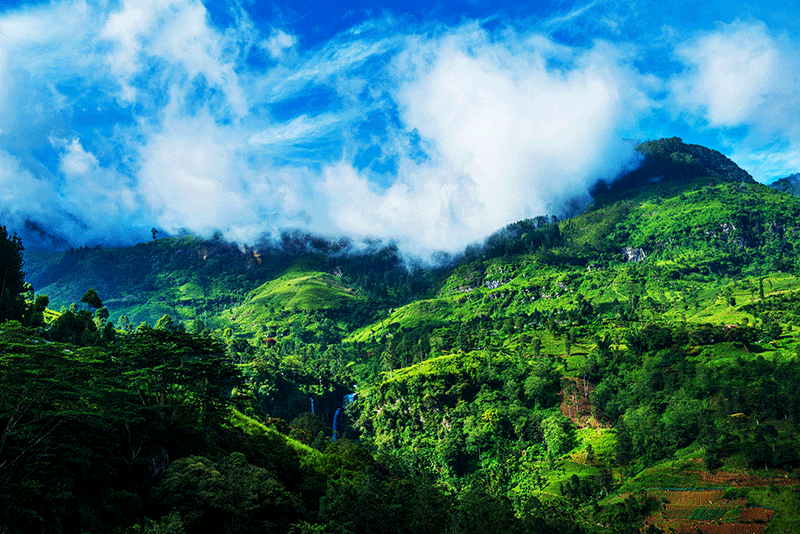
2 weeks Sri Lanka itinerary: Best for mountains and Tea
There are many reasons to visit Nuwara Eliya– British-built whitewashed Theodor-styled mansions at every turn, the beautifully landscaped flower gardens, the healing climate, green-capped mountains, the Gregory lake teeming with trout fish and the city’s role as Sri Lanka’s hill country heartbeat, thanks to its cascading waterfalls. But none of these reasons is more compelling than the mild taste, aroma-filled and pale-coloured Tea, borne amongst the cool green-capped mountains of the hill country.
The portion of the central mountain range of Sri Lanka that surpasses the height of 500 meters above sea level, is the centrepiece of Sri Lanka’s world tea-renowned tea country. Here, a combination of a warm, sunny climate during the day and a chilly windy climate after the sunset along with soil provides the ideal conditions for Tea production – the surrounding area is home to more than a hundred Tea factories. It is one of the purest beverages on earth and contains no added chemicals at all.
Sri Lanka is one of the biggest tea producers in the world and produced 300 million kilograms of tea in 2019. The tea industry is widely distributed all around the island, but its impact on the economy of the people living in the Sri Lankan hill country is immense. Tea needs human intervention at every step along the way. Most people in the mountains are actively engaged in the tea industry and about 1 million people in Sri Lanka’s workforce have resorted to the tea industry.
Drop into one of the tea factories in Nuwara Eliya to witness the manufacturing process, taste a cup of unblended Ceylon tea and buy a few sachets of fine Ceylon tea. Ceylon tea is categorized into many varieties, and among Ceylon’s, the most south-after tea is the BOPF coming from higher elevated regions such as Nuwara Eliya, which has a light colour, strong aroma and is accompanied by a mild taste. Tea is also available with added aroma and flavour such as vanilla Tea, Apple Tea orange tea etc.
Further information: Visiting a tea factory on a Sri Lanka trip, please write to admin@seerendipitytours.com for reservations
Where to eat: There is a large number of restaurants and hotels in the city that provide local, and foreign foods as well as beverages.
Where to stay: The four-star Hotel Mirage palace occupies a small, converted 18th-century British-built palace, and combines historic character with nature. The hotel is small with 25 rooms and provides cosy rooms, which have a stove for firewood. The palace had been possessed by a wealthy planter featuring architectural features such as the soaring ceilings point to a distinguished past, while white-dominated colour schemes and modern bathrooms ensure contemporary comforts.
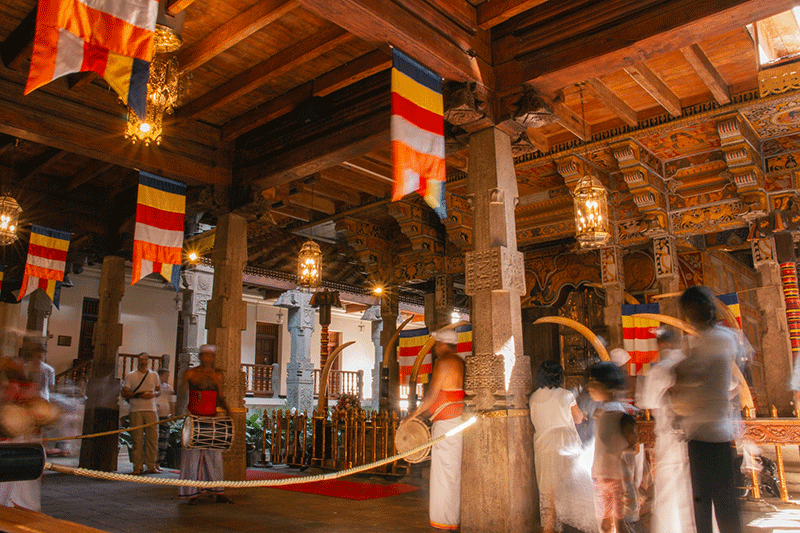
2 weeks Sri Lanka itinerary: visiting Kandy for architecture
Kandy is where Sri Lanka’s culture and heritage legacy is brought to life. For more than 300 years, The legitimate king of Sri Lanka, who ruled the country from Kandy and Portuguese rulers (from 1505 to 1656) as well as the Dutch colonial administrators (from 1656 to 1796) battled over the Kandyan Kingdom of Sri Lanka. And it was Kandy- the capital of Sri Lanka’s monarchy until it was ceded to the British crown in 1948.
Exquisite in the intensity of its craftmanship, and extravagant in its scope, the tooth relic temple of Kandy is the culmination of a vision – of paradise, of earthly power, and of the vanity of attempting to combine the two.
Once, it was the permanent residence of the Kandyan King, who imagined that the Kandyan kingdom would last forever, and a formidable defensive fortress because they feared it wouldn’t. The tooth relic temple is the oldest tourist attraction in Kandy and is a part of a UNESCO world heritage site. The temple is built on a wooden structure and it is still as strong as it had been over the last five hundred years, the combination of building materials (stone, wood, ceramic and plaster) with typical Sri Lankan characteristics (intricate wood carvings, interwoven geometric patterns and stuccoed ceilings) reaches a point close to perfection.
The main area of the tooth temple is consisting of 2 stories building which has a copper, shining roof. The roof can be witnessed far away from the temple, due to the shining roof, likes a gold plate, this is the most ancient part of the tooth temple and “Udamala” or the upper floor is dedicated to the most sacred object on the island left eye tooth of Buddha. This is a very rare religious object, which has been subjected to veneration around the entire Buddhist world.
Further information: The best time to visit the tooth temple is during the morning, afternoon and evening “pooja hours” or ceremony hours. The temple including the shrine room where the tooth relic rests is open only during the pooja hours. Seerendipity tours arrange daily trips to Kandy and the tooth temple from Colombo, and this one-day trip includes the tooth temple, Pinnawala orphanage, spice garden, and many other tourist places in Kandy.
Where to eat: Eating fine Sri Lankan food in downtown Kandy, where dozens of local restaurants cater to visitors. They not only serve local food but also any kind of international dish on request.
Where to stay: Accommodations are arranged around Kandy lake, giving easy access to all important tourist places in Kandy such as tooth relic temple, Udawattakele sanctuary, Kandyan arts and crafts, Peradeniya botanical and occupying an 18th-century colonial mansion, one of the most loved city hotels in Kandy. It has the colonial flair and has modern rooms, some with partial Kandy lake views from the balconies; while some other rooms give a direct and clear panoramic view of the tooth relic temple. The 10-minute walk along the bank of Kandy lake from the hotel to the city itself is a safari, which allows you to see turtles, monitors, monkeys, and many species of birds.
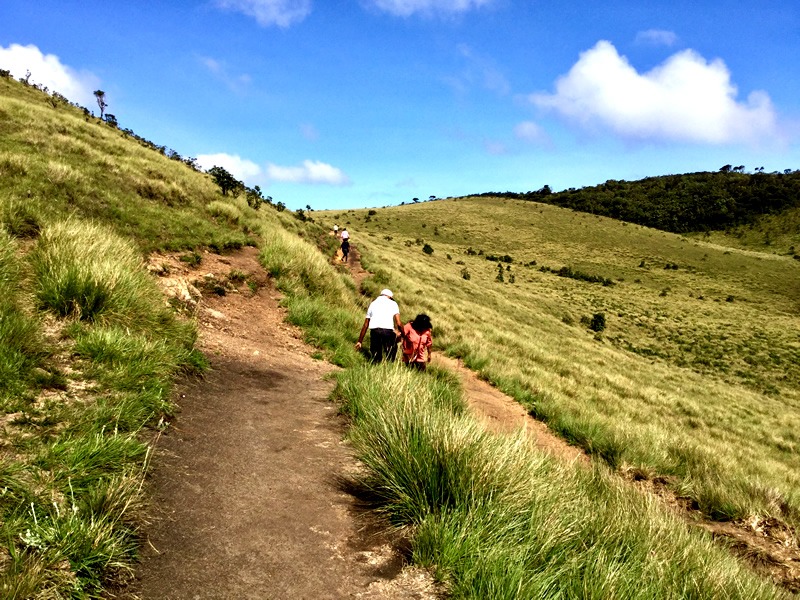
2 weeks Sri Lanka itinerary: Best for walking
Mountain resorts like Nuwara Eliya and Bandarawela provide the dram amidst rolling hills of Sri Lankan central highland, but towards the southern slopes of the central hills, rises the tranquil and laid-back village of Ella. This mountain resort is quiet rural byways like an apparition, the natural world takes over. The rugged terrain of Ella is home to a large tract of pristine vegetation as well as Great buttresses of granite rock silhouetted against the blue sky and white clouds soar above a forested landscape tinged with green even when the rest of Ella turns brown under a baking sun during the dry season.
Hundreds of small rest houses, guest houses, small hotels and rented rooms are the main form of accommodation for travellers in Ella. And most of them harness the breathtaking scenery across the Ella gap, and the view of the Ella gap from the room is a vital marketing tool for them to attract customers.
Ella is an ideal base for a light adventure tour to explore Sri Lanka’s mountains. Many important tourist attractions such as Ella gap, Ravana waterfalls, Horton plains national park as well as many dozens of mountains, and patches of forests provide narrow paths for hours-long trekking and hiking routes.
Nuwara Eliya is one of Sri Lanka’s most striking mountain resorts, sashaying up the craggy, the highest point on the island within its border. Ella has a totally different flair for natural beauty and plays second fiddle to the cinematic beauty of the landscape that surrounds Nuwara Eliya.
Ella has calm and quiet settings making it ideal for leisure seekers. Lush green foliage dominates every part of this mountain resort and high-rise concert towers have not been able to penetrate the beautiful countryside. Among the countless trekking routes that weave through the Ella gap, mini Adams peak and Ravana waterfalls are accessible off the road and are the most enjoyable and spectacular.
The initial trail is quite easy and on a flat surface, a few minutes later the trek in Ella gap starts to drop through the densely wooded country and terraced vegetable gardens as well as tea plantations. The final descent through the deepest part of the ravine, with steep climbing down to the base, where cliffs towers on either side of you.
“Ella is a perfect eco-holiday destination with the chance to see wildlife, Ella is the best place on the island to witness many species of avian fauna species,” says Gamini, a local naturalist. “the ecosystem in Ella is unique in many ways compared most other mountain resorts. It is not only birds; there are many other animals that can be spotted here like wild boar, mongoose, chameleon, monitor lizards, monkey.”
Further information: The permit is required for Hiking and trekking in Ella, however, it is recommended to hire a nature guide in order to not to lost in the woods. Seerendipitytours organize the Ella trips from Colombo, which also include the scenic upcountry rail trip. Please contact them at seerendipitytourslk@gmil.com for more information
Where to eat Ella: is a small town and Ella-Wellawaya cuts through the city. Many dozens of restaurants are dotted along the main road within the city limits and give ample opportunities for travellers to find a peaceful spot for a delicious meal.
Where to stay: The mountain resort is dominated by small family-run hotels and guest houses. They are mainly serving for budget-conscious travellers; therefore, most places are equipped with basic facilities and amenities. However, there are few hotels with 4-5* facilities, while give a breathtaking view of Ella’s gap from the top of the mountain. If you like to find a lodge with the atmosphere of a mountain lodge combined with the quality of a hotel combined with the scenic beauty of Ella gap from its terrace please contact seerendipity tours.
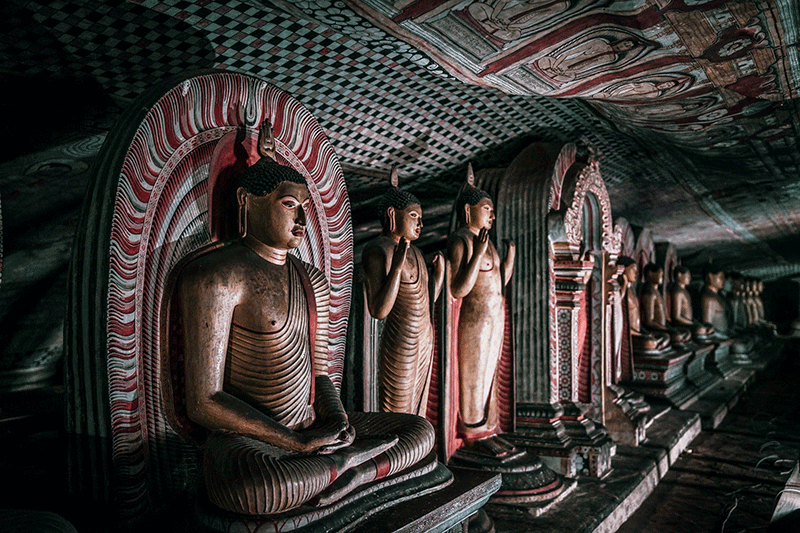
2 weeks Sri Lanka itinerary: best for historical wonders
The cultural triangle is the soul of Sri Lanka, where hundreds of historical monuments sit under the scorching heat of Sri Lanka’s north-central plains. This beguiling cultural triangle houses many UNESCO world heritage sites with high-calibre ancient monuments. The popular cities in the cultural triangle such as Anuradhapura and Polonnaruwa once were writ large and in microcosm: grand tapestries with labyrinthine canals and lakes connecting them. Among the canals and lakes, there were hundreds of temples, stupas, palaces, gardens and many ancient structures belonging to the ancient culture that flourished from the 3rd century BC to the 11th century AD.
All great stories of Sri Lankan culture start in the cultural triangle of Sri Lanka. The cultural triangle is considered the cradle of Buddhism in Sri Lanka, Mihintale. Buddhism is the state religion for many thousands of years, King Devanampiyatissa was the first Buddhist King of Sri Lanka, who was given the status of Buddhist by Indian monk Mahinda in the 3rd century BC.
The great culture once flourished in the north-central dry zone of Sri Lanka had a huge blow by the invaders of southern India, who vandalized the stupendous Buddhist structures and looted the assets of Sinhalese rulers. The kings retreated to the interior of the island, looking for safer places to live, due to the unceasing invasions and abandoned the ancient cities, allowing nature to reclaim its assets.
Later, during the British administration, ancient cities were unearthed. The excavations are still taking place, over the last hundred years and the history of Sri Lanka is rewritten over and over again when facts are discovered. Recently a group of archaeologists had been able to discover some stone implements belonging to humans that lived during the stone age in Sri Lanka (more than 40000 years). Based on the new finding the stone age man of Sri Lanka had used the arrows to kill fast-moving animals such as squirrels and monitor lizards, suggesting that the arrow was first used in Sri Lanka outside of Africa.
Visitng cultural triangle on 2 week Sri Lanka tour
The cultural triangle is one of the most important tourist attractions in Sri Lanka. Sri Lanka’s cultural triangle harbours many hundreds of ancient temples, palaces, gardens, and many other ancient structures. This archaeological zoo testifies to the advanced culture that existed in Sri Lanka. The very first activity on this Sri Lanka tour is to explore the historical and religious monuments in the cultural triangle. Your cultural triangle tour starts in Anuradhapura and ends in Kandy, so, be prepared to visit many dozens of Buddhist temples and other religious sites during the first few days of your trip.
What are the historical places included in Sri Lanka 2 weeks tour package?
Sri Lanka 2 weeks tour itinerary includes a large number of cultural, historical and religious attractions. I mention a few of those historical places here that are mostly packed into most 2-week Sri Lanka tour itineraries.
- Anuradhapura
- Polonnaruwa
- Sigiriya
- Dambulla
- Kandy
- Galle Fort
- Sita temple
- Aukana Buddha statue
- Mihintale temple
Further information: Seerendipity tours organize daily trips to important tourist places in the cultural triangle. The 3 days Sri Lanka cultural triangle itinerary cover all important places such as Anuradhapura, Polonnaruwa, Sigiriya, Dambulla as well as Kandy, write for more information at admin@seerendipitytours.com.
Where to eat: All cities of the Cultural Triangle are well-developed for the tourism industry and provide plenty of opportunities for dining and accommodation.
Where to stay: The cultural triangle not only has historical splendor but also natural beauty. A large tract of pristine forests enhances its natural beauty while harbouring a large number of animals as well as many species of avian fauna species. Most hotels in the cultural triangle make use of this natural beauty and unlike city hotels most hotels in the cultural triangle allocate ample space for every room and its occupants, making it possible for travellers to hear the soothing music of birds from their room or garden.

Heya i am travelling for teh first time to Sri Lanka. I never been to Asia before. Your article on 2 weeks tour to sri Lanak is very useful and I was able to get a good idea about planning my trip.
me.